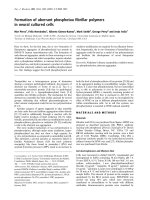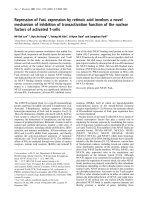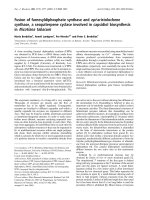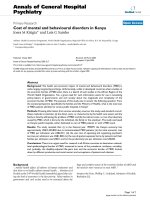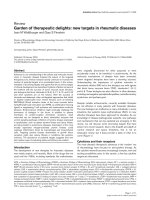Báo cáo y học: "Incidence of hospital referred head injuries in Norway: A population based survey from the Stavanger region" ppsx
Bạn đang xem bản rút gọn của tài liệu. Xem và tải ngay bản đầy đủ của tài liệu tại đây (251.62 KB, 5 trang )
BioMed Central
Page 1 of 5
(page number not for citation purposes)
Scandinavian Journal of Trauma,
Resuscitation and Emergency Medicine
Open Access
Original research
Incidence of hospital referred head injuries in Norway: A population
based survey from the Stavanger region
Ben Heskestad
1,2
, Roald Baardsen
2
, Eirik Helseth
1
, Bertil Romner
3
,
Knut Waterloo
4
and Tor Ingebrigtsen*
3
Address:
1
Department of Neurosurgery, Ullevål University Hospital, Oslo, Norway,
2
Department of Neurosurgery, Stavanger University Hospital,
Stavanger, Norway,
3
Department of Neurosurgery, Institute for Clinical Medicine, University of Tromsø, Tromsø, Norway and
4
Department of
neurology, University Hospital of North Norway, Tromsø, Norway
Email: Ben Heskestad - ; Roald Baardsen - ; Eirik Helseth - ;
Bertil Romner - ; Knut Waterloo - ; Tor Ingebrigtsen* -
* Corresponding author
Abstract
Background: In three previous Norwegian studies conducted between 1974 and 1993, the annual
incidence rates of hospital admitted head injuries were 236, 200 and 169 per 100,000 population.
The aim of this study was to describe the incidence of head injury in the Stavanger region and to
compare it with previous Norwegian studies.
Methods: All head injured patients referred to Stavanger University Hospital during a one-year
period (2003) were registered in a partly prospective and partly retrospective study. The
catchment area for the hospital is strictly defined to a local population of 283,317 inhabitants
(2003).
Results: The annual incidence rate was 207/100,000 population for hospital referred head injury
and 157/100,000 population for hospital admitted head injury. High age- and sex specific incidence
rates were observed among the oldest, and the highest rate (882/100,000) among men above 90
years. More than 50% of the injuries were caused by falls.
Conclusion: Comparison with previous Norwegian studies indicates decreasing annual incidence
rates for hospital admitted head injury during the last 30 years.
Introduction
Head injury accounts for the majority of trauma deaths
and contributes strongly to costs in the health care system
[1,2]. Epidemiological studies provide information about
the occurrence of head injury, the nature of its distribu-
tion, the severity of cases and causes, and is therefore
required for prevention and effective treatment for head
injured patients.
Reviews of head injury epidemiology conclude that com-
parison of incidence rates from different studies is difficult
because of variations in definitions and inclusion criteria,
admission policies and health care systems within and
between countries [1,2]. The number of patients pre-
sented to a hospital after head trauma is most likely the
best measurement for the incidence of head injury [2]. In
a recent review by Tagliaferri et al. [1], annual incidence
rates of hospital admitted head injuries varied between 91
Published: 20 February 2009
Scandinavian Journal of Trauma, Resuscitation and Emergency Medicine 2009, 17:6 doi:10.1186/1757-7241-17-6
Received: 14 September 2008
Accepted: 20 February 2009
This article is available from: />© 2009 Heskestad et al; licensee BioMed Central Ltd.
This is an Open Access article distributed under the terms of the Creative Commons Attribution License ( />),
which permits unrestricted use, distribution, and reproduction in any medium, provided the original work is properly cited.
Scandinavian Journal of Trauma, Resuscitation and Emergency Medicine 2009, 17:6 />Page 2 of 5
(page number not for citation purposes)
and 546 per 100,000 population per year in European
countries. The observed incidence rates have typically
been high in South Europe and low in Scandinavia. In
three previous Norwegian studies conducted in 1974,
1979 and 1993, the annual incidence rates were 236, 200
and 169 per 100,000 population, respectively [3-5]. A
Swedish study with data collection from 1987–2000
including 22,000 patients showed an average annual inci-
dence rate of 229 per 100,000 population [6], while a
recent study with data collection in 2005 and 2006 from
the Norwegian capital region showed a surprisingly low
annual incidence rate of 83.3 per 100,000 population [7].
The aim of the present study was to describe the incidence
of head injury in the Stavanger region and to compare it
with previous Norwegian studies.
Materials and methods
Study region
The University Hospital of Stavanger is located in the
south-western part of Norway as a university hospital for
a population of 385,020 inhabitants. It also serves as a
local hospital for 283,317 of these inhabitants (Statistics
of Norway, 2003). The catchment area for the local hospi-
tal function is strictly defined to the city of Stavanger and
15 surrounding municipalities. There are no other hospi-
tals or private clinics in this region.
Study population
In Norway, the primary health care system operates emer-
gency services staffed with general practitioners (GP),
while the secondary health care system operates hospitals.
Most head injured patients are seen by a GP at a primary
health care facility before eventual referral to hospital, but
severely injured patients are transported directly to hospi-
tal by ambulance, and low numbers of patients not com-
plying with the system may access hospitals directly.
This population based survey includes all head-injured
patients (n = 585) referred to any department at the hos-
pital during a one-year period (2003). Patients referred to
the emergency room but discharged after assessment were
also included.
Data collection was prospective for patients 15 years and
older (n = 403), and retrospective for patients younger
than 15 years (n = 182). Case ascertainment procedures in
the prospective part of the study included continuous data
collection by the physician on call in all cases, by comple-
tion of a registration form with demographic and clinical
data. Electronic searches in the hospitals patient adminis-
trative database was performed every second day for iden-
tification of eventual patients not included, and the same
data collection form was completed by the primary author
within three days after injury by review of the patient files.
The electronic search identified all patients with ICD-10
codes S00 through S09 with subgroups.
Patients younger than 15 years were identified retrospec-
tively with a similar electronic search, and the data collec-
tion form was completed by the primary author by review
of patients files.
Inclusion and exclusion criteria
For the purpose of this study, head injury was defined as
physical damage to the brain or skull caused by external
force.
Patients with isolated injuries to the scalp, face or cervical
spine and patients with birth injuries were excluded. Head
injured patients referred to our hospital who were not reg-
istered in the Norwegian Population Registry as citizens in
the hospitals catchment area were not included in the
study. Incidence rates were calculated on the basis of
demographic data from 2003 (283,317 inhabitants;
source: Norwegian Social Science Data Services).
Prior to the data collection period the Scandinavian
guidelines for management of minimal, mild and moder-
ate head injuries had been implemented as a standard for
assessment and treatment of head injured patients in our
hospital [8]. This guideline classifies patients according to
the Head Injury Severity Scale, which is based on Glasgow
Coma Scale (GCS) scoring, the presence (and duration) or
absence of loss of consciousness in the history, and the
presence or absence of focal neurological deficits [9]. This
scale was developed after examination of the outcome of
almost 25,000 head-injured patients. It divides head
injury into four severity grades: minimal, mild, moderate
and severe. We applied the Scandinavian guidelines
because they successfully separate minimal injuries with
negligible risk of complications from mild and severer
injuries requiring computerised tomography or observa-
tion [8,10].
Statistics
We used the Statistical Package for the Social Sciences
(SPSS) for Windows (release 14.0; SPSS Inc., Chicago, IL)
for all statistical analyses. Comparisons of multiple pro-
portions were performed with the Kruskal-Wallis H test.
P-values < 0.05 were considered statistically significant.
Results
Incidence rates and severity distribution
During the year 2003, 585 head injured patients were
referred to our hospital and included in this study. The
annual incidence rate was 207/100,000 population. After
evaluation in the emergency-room, 446 (76%) were
admitted for hospitalisation giving an admission rate of
157/100,000 population. The distribution of head injury
Scandinavian Journal of Trauma, Resuscitation and Emergency Medicine 2009, 17:6 />Page 3 of 5
(page number not for citation purposes)
severity according to the HISS at the time of examination
was 153 minimal, 339 mild, 16 moderate and 77 severe.
The admission rate increased significantly (p < 0.001)
with severity of injury (73% for minimal, 88% for mild,
100% for moderate and 97% for severe).
The sex-specific incidence rates were 258/100,000 for
males and 156/100,000 for females, giving a male pre-
ponderance of 1.7:1.0. High age-specific incidence rates
for men were found in the age groups 10–24 years, with
the peak (428/100,000) among teenagers between 15 and
19 years (Fig. 1.) The same trend was observed for women,
with a less pronounced overrepresentation of teenagers.
In both genders, the highest age and sex specific incidence
rates were observed among the oldest, with the highest
rate in the study (882/100,000) for men above 90 years.
Cause of injury
The injuries were caused by falls in 299 (51%), traffic acci-
dents in 126 (21%), assaults in 81 (14%) and other causes
in 79 (14%) cases. The male: female ratio was highest for
head injury caused by assaults (2.9:1) and lowest for head
injury caused by traffic accidents (1.4:1).
Falls were the most common cause of injury in children
younger than 10 years and in adults 40 years and older as
shown in Fig. 2. In the age groups between 10 and 40
years, falls and road traffic accidents accounted for
approximately equal proportions of the injuries, while
assaults were observed mainly between 15 and 24 years.
We did not observe any significant relation between the
cause of head injury and head injury severity.
Radiological Findings
Table 1 shows that the use of cranial computerised tomog-
raphy (CT) increased significantly (p < 0.001) with sever-
ity of injury, from 55% in minimal injuries to 99% in
severe injuries. In those examined with CT, a skull fracture
or intracranial lesion was revealed in 1% of minimal, 4%
of mild, 56% of moderate and 99% of severe head inju-
ries. A total number of 12 (2%) epidural hematomas were
observed in the 585 patients, and 11 of these occurred in
patients with injuries classified as moderate or severe.
Discussion
The main finding in this study is an annual incidence rate
of 207/100,000 population for hospital referred head
injury and 157/100,000 population for hospital admitted
head injury. High age- and sex specific incidence rates
were observed among the oldest and the highest rate
(882/100,000) for men above 90 years. More than 50% of
the injuries were caused by falls.
A recent review of European head injury epidemiology
included 23 studies from 14 countries and concluded that
an overall incidence rate of about 235/100,000 popula-
tion per year could be derived [1]. Comparison of head
injury incidence rates from different studies is difficult
due to variability in inclusion criteria, admission policies
and health care systems. Caution must therefore be taken
when interpreting these results from the present study.
Comparison with previous Norwegian and Nordic studies
is probably most relevant.
Incidence rates from three previous Norwegian studies
conducted in 1974, 1979 and 1993 are available for hos-
pital admissions only [3-5]. Interestingly, a clear trend
towards reduced incidence is present, as the annual
admission rates in these studies were 200, 236 and 169/
100,000 population respectively. In the present study, a
further reduction to 157/100,000 population was
observed. A recent study from the Norwegian capital
region (Oslo) reported a surprisingly low incidence of
hospital admitted patients (83.3/100,000 population)
[7]. The authors speculate that this might be the result
from effective prevention programs, but they may not
have taken into consideration that a significant propor-
tion of head injured patients in Oslo is treated at an
Population tree depicting age- and sex-specific annual inci-dence rates (cases/100,000 population) of hospital-referred head injury in the Stavanger regionFigure 1
Population tree depicting age- and sex-specific
annual incidence rates (cases/100,000 population) of
hospital-referred head injury in the Stavanger region.
Scandinavian Journal of Trauma, Resuscitation and Emergency Medicine 2009, 17:6 />Page 4 of 5
(page number not for citation purposes)
advanced outpatient clinic with facilities for overnight
observation.
A national Danish study for the period 1979–1996
reported a decrease in the incidence of hospital admitted
head injury from 265 to 157 per 100,000 population [11].
This is almost identical with the trend in Norway. In Fin-
land, a study based on data from the National Hospital
Discharge Register for the period 1991 to 2005 showed a
stable incidence [12]. Taken together, the incidence of
hospital admitted head injuries in the Nordic countries
seems to have been significantly reduced during the last
30 years, and especially the 1980's and 1990's.
Causes of head injury by specific age groupsFigure 2
Causes of head injury by specific age groups.
Table 1: Distribution of head injury cases, use of computed tomography (CT) and CT findings in 585 head injured patients.
Injuries revealed by CT (n = number of observations)
Severity category Number of cases Proportion examined
with CT
(n = number of cases)
Proportion with CT
verified injury
(n = number of cases)
Cerebral contusion tSAH SDH EDH Fracture
Minimal 153 84 (55%) 1 (1%) 0 0 0 0 1
Mild 339 284 (84%) 15 (4%) 3 1 2 1 8
Moderate 16 16 (100%) 9 (56%) 3 4 2 1 5
Severe 77 77 (100%) 76 (99%) 38 23 35 10 43
Total 585 461 (79%) 101 (22%) 44 28 39 12 57
tSAH: traumatic subarachnoid haemorrhage; SDH: subdural haematoma; EDH: epidural haematoma
Publish with BioMed Central and every
scientist can read your work free of charge
"BioMed Central will be the most significant development for
disseminating the results of biomedical research in our lifetime."
Sir Paul Nurse, Cancer Research UK
Your research papers will be:
available free of charge to the entire biomedical community
peer reviewed and published immediately upon acceptance
cited in PubMed and archived on PubMed Central
yours — you keep the copyright
Submit your manuscript here:
/>BioMedcentral
Scandinavian Journal of Trauma, Resuscitation and Emergency Medicine 2009, 17:6 />Page 5 of 5
(page number not for citation purposes)
Most studies report an overrepresentation of teenagers
and young adults, especially men [2,5]. Comparison
between our previous study in Tromsø, Norway, in 1993
and the present survey indicates a modification of this, as
the age- and sex specific rates for male teenagers in the pre-
vious study was about 500/100,000 population per year,
while the corresponding figure in Stavanger in 2003 was
approximately 300/100,000 per year. It could be specu-
lated that preventive measures such as bike helmets and
other efforts to reduce the frequency of traffic accidents
have been specifically effective in these age groups.
The very high incidence rate for head injuries caused by
falls among old people above 80 years is an interesting
observation in the present study, as the incidence for
those above 80 is twice as high as for teenagers. A trend
towards reduced incidence rates among teenagers and
young adults and increased rates for the elderly is consist-
ent in other Nordic studies [5-7,11]. This could be an
effect of extensive injury preventive measures directed
towards traffic accidents and sports injuries [13]. Now,
increased focus on prevention of falls among the elderly
may be more efficient in achieving further reduction in
head injury incidence.
The Scandinavian guidelines for management of mini-
mal, mild and moderate head injuries recommend outpa-
tient management of patients with head injuries classified
as minimal or mild [8]. Implementation of this practice
has probably contributed to the reduction of hospital
admission for head injuries [14]. On the other hand the
high admission rate (73%) and the frequent use of CT
(55%) for patients with injuries classified as minimal in
the present study, is surprising and not in accordance with
the management recommended by the guidelines pub-
lished by the Scandinavian Neurotrauma Committee [8].
This practice contributes to a high admission rate and
could influence comparison with other studies. A separate
study of guideline compliance would be reasonable.
This study has limitations. The data collection was par-
tially retrospective, which may have influenced the accu-
racy of the inclusion procedure and the classification of
the injuries. The study sample is relatively small and this
implies a risk for random variation (type II error).
Conclusion
Comparison with previous Norwegian studies indicates
decreasing annual incidence rates for traumatic head
injury during the last 30 years.
Competing interests
The authors declare that they have no competing interests.
Authors' contributions
BH and RB designed the study. BH and RB conducted data
collection. All authors participated in data interpretation,
literature research and preparation of the manuscript.
References
1. Tagliaferri F, Compagnone C, Korsic M, Servadei F, Kraus J: A sys-
tematic review of brain injury in Europe. Acta Neurchir (Wien)
2006, 148:255-268.
2. Jennet B: Epidemiology of head injury. J Neurol Neurosurg Psychi-
atry 1996, 60:362-369.
3. Edna TM, Cappelen J: Hospital admitted head injury: A pro-
spective study in Trøndelag, Norway, 1979–80. Scand J Soc
Med 1984, 12:7-14.
4. Nestvold K, Lundar T, Blikra G, Lønnum A: Head injuries during
one year in a central hospital in Norway: A prospective
study. Epidemiologic features. Neuroepidemiology 1988,
7:134-144.
5. Ingebrigtsen T, Mortensen K, Romner B: The epidemiology of
hospital-referred head injury in northern Norway. Neuroepi-
demiology 1998, 17:139-146.
6. Kleiven S, Peloso PM, von Holst H: The epidemiology of head
injuries in Sweden from 1987 to 2000. Inj Control Saf Promot
2003, 10:173-80.
7. Andelic N, Sigurdardottir S, Brunborg C, Roe C: Incidence of Hos-
pital-Treated Traumatic Brain Injury in the Oslo Population.
Neuroepidemiology 2008, 30:120-128.
8. Ingebrigtsen T, Romner B, Kock-Jensen C: Scandinavian guide-
lines for initial management of minimal, mild, and moderate
head injuries. The Scandinavian Neurotrauma Committee. J
Trauma 2000, 48:760-766.
9. Stein SC, Spettell C: The Head Injury Severity Scale (HISS): a
practical classification of closed-head injury. Brain Injury 1995,
9:437-444.
10. Ibanez J, Arikan F, Pedraza S, Sanchez E, Poca MA, Rodriguez D, Rubio
E: Reliability of clinical guidelines in the detection of patients
at risk following mild head injury: results of a prospective
study. J Neurosurg 2004, 100:825-834.
11. Engberg Aa, Teasdale TW: Traumatic brain injury in Denmark
1979–1996. A national study of incidence and mortality. Eur
J Epidemiology 2001, 17:
437-442.
12. Koskinen S, Alaranta H: Traumatic brain injury in Finland 1991–
2005: A nationwide register study of hospitalized and fatal
TBI. Brain Injury 2008, 22:205-214.
13. Ytterstad B: The Harstad Injury Prevention Study. A decade
of community-based traffic injury prevention with emphasis
on children. Postal dissemination of local injury data can be
effective. Int J Circumpolar Health 2003, 62:61-74.
14. Müller K, Waterloo K, Romner B, Wester K, Ingebrigtsen T: Mild
head injuries: Impact of a national strategy for implementa-
tion of management guidelines. J Trauma 2003, 55:1029-1034.



